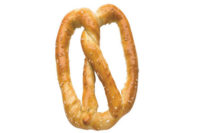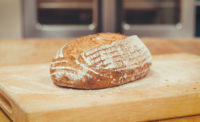Demand for easy-open/easy-close features, flexible pouches and smaller sizes are driving the latest advances in packaging materials for today’s bakery and snack food market, according to leading packaging manufacturers. The latest packaging materials even provide audio and tactile feedback to consumers. The use of “green” materials and sustainability throughout the supply chain is another major movement.
“Consumers like to indulge themselves and are seeking premium products in the bakery and snack categories,” says Paul Pritchett, marketing manager, Printpack Inc., Atlanta. “Packaging is becoming more sophisticated as a result. We’re seeing an increase in features that improve the consumer experience with the brand: Easy-open; recloseability to maintain product freshness; smaller package sizes for smaller families; and controlled portions. Also, brand managers continue to adopt eye-catching graphics that help their products get noticed on the shelf.”
Demand for easy-open/easy-close features, flexible pouches and smaller sizes are driving the latest advances in packaging materials for today’s bakery and snack food market, according to leading packaging manufacturers. The latest packaging materials even provide audio and tactile feedback to consumers. The use of “green” materials and sustainability throughout the supply chain is another major movement.
“Consumers like to indulge themselves and are seeking premium products in the bakery and snack categories,” says Paul Pritchett, marketing manager, Printpack Inc., Atlanta. “Packaging is becoming more sophisticated as a result. We’re seeing an increase in features that improve the consumer experience with the brand: Easy-open; recloseability to maintain product freshness; smaller package sizes for smaller families; and controlled portions. Also, brand managers continue to adopt eye-catching graphics that help their products get noticed on the shelf.”
Flexibles that ‘talk’
The use of flexible packaging continues to dominate the bakery and snack food industry and shows no sign of declining in popularity, experts agree. Five years ago, many consumers wouldn’t have associated flexible packaging with salsa, cereal, liquid flavorings, snack kits and more. Now, grocery store shelves across the nation are lined with flexible pouches and bags that meet consumers’ needs for smaller portions, freshness, source reductions and longer shelf life.
Flexible pouches provide numerous advantages for producers as well, such as maximizing storage space, enhancing transportation efficiency and achieving sustainability goals.
Zip-Pak, an ITW company in Manteno, Ill., launched Vector, a resealable matrix reclosure that offers easy sealing alignment, says Art Malcomson, director of sales and marketing. The resealable matrix is actually a series of small matrices that interlock when pushed together, instead of a traditional track zipper.
Using the Vector concept, Zip-Pak has launched a package format called Zip360 that offers greater product access because the reclosure is one continuous piece of zipper that hasn’t been sealed together on each end. This means the proprietary self-sealing matrix closes securely without the need to exactly line up opposing segments, providing a tactile, audible snap that signals that fastening is complete. The airtight seal also helps lock in product freshness.
In terms of reclosure, consumers are increasingly looking for feedback that tells them a package has been properly resealed, Malcomson says. “To address this need, Europe Zip-Pak recently launched Sensus, a zipper that provides audio and tactile feedback that the zipper has truly been closed,” he adds. “This product will soon be available in North America.”
Hartsville, S.C.-based Sonoco, a global provider of packaging products and services, has introduced the SealTab reclosure, which allows consumers to open a bag from the top and access the product. “When the user wants to close the bag, they pull a tab near the top, which activates a scored flap, backed by a resealable adhesive,” explains Pete D. Gioldasis, division marketing manager. “The top section of the bag can then be folded forward and the bag closes, retaining freshness, without the need for any clips.” The bag also provides storage convenience because it can be folded down multiple times as the product is consumed, so the bag gets smaller as its contents decrease.
Printpack’s Pritchett agrees that for years there’s been a major focus by packaging manufacturers on creating packaging that’s easy to open and reclose. “We’ve seen a lot of interest in our Reseal-it technology both in the U.S. and in Europe,” he notes. “Reseal-it labels come in various shapes and sizes and are custom-designed to fit flowrap and thermo-formed or pre-formed tray applications. Reseal-it labels add easy-open, reclosable and tamper-evident functionality to packages to improve the consumer experience.”
The labels also provide ample space for high-impact printing, Pritchett adds. “One example of this technology that fits into the bakery and snacks category is the sandwich thins package produced for Kroger. Another popular example of Reseal-it in Europe is the Walkers Shortbread cookies package.”
Shelf-life extenders
Packaging that helps extend the shelf life of bakery and snack foods, such as “active” packaging technologies, are gaining momentum as well, according to Kari Dawson-Ekeland, marketing director, center store market, Sealed Air Corp., Food and Beverage Division, Duncan, S.C. One example is Sealed Air’s Cryovac Freshness Plus active packaging technology, which incorporates oxygen- and/or odor-scavenging properties within the packaging film itself, keeping food items fresh without the need to include sachets or other additives or preservatives.
“Freshness Plus oxygen-scavenging films extend shelf life, maximize color and flavor and preserve freshness by reducing confined odors inside snack and bakery packages,” says Dawson-Ekeland. “These films can actively remove oxygen as well as prevent oxygen egress into the package, which helps reduce mold growth and keeps items fresh longer.” Baked goods, premixed bakery ingredients and nuts are among the products benefiting from this type of packaging.
The Dow Chemical Co., Midland, Mich., has introduced three packaging solutions for bakery and snack producers, according to Greg Bunker, marketing director for Dow’s North American Performance Packaging Flexible Food and Specialty Packaging Division. One is a 100% polyethylene (PE) stand-up pouch (SUP) that offers hermetic sealing to prevent leaks and punctures. It can be recycled with existing PE bag and film recovery streams. “The PE pouch also provides end users with a glossy, aesthetically pleasing package that attracts consumers to store shelves,” Bunker says.
Dow also has introduced SEALUTION Peel Polymers, a polyolefin-based material designed for easy-open packaging that’s used in dry-food bag liners for cereals, crackers and snacks. The material offers easy-open functionality, resists splitting and requires no online blending, according to the company.
OPULUX Optical Finishes, another Dow introduction, provides uniform acrylic beads that impart reduced gloss and a soft, luxurious touch, while maintaining a high degree of clarity. “This use of acrylic bead technology and polymer design can help package makers and brand owners create distinctive, luxurious finishes for packaging and labels that provide a rich matte look, and a soft touch,” Bunker notes.
Technical Help in Engineering and Marketing (T.H.E.M.), Marlton, N.J., has developed stick-packs capable of dispensing liquids, gels and pastes for single-serve snacks. “We offer a range of dispensing methods that are responsive to the consumer-use occasion,” says Neil Kozarsky, president. “The benefits of using these sticks include portability, portion-control and ease of use.”
The company also has developed a snap-opening pack that gives the consumer an audible cue that signals readiness and freshness. Called Snapsil, these single-serve packages can be used for dry and liquid products that require pouring or squeeze pressure. “The semi-rigid base and lid material offer clear source-reduction potential for applications that currently use bottles or cans,” says Kozarsky.
Sustainability stars
Sustainable packaging is becoming mandatory among manufacturers and users of packaging materials throughout the supply chain. As the Foodservice Packaging Institute, Falls Church, Va., states in its fourth annual Trends Report: “‘Green’ isn’t a trend, it’s standard operating procedure. As in past years, the idea of ‘green’ or ‘sustainable’ packaging is a hot topic. However, no longer is this simply a packaging trend; it truly has become an established part of doing business in the industry.”
Pritchett notes, “We are always evaluating new materials that address sustainability issues, from new shrink labels that enable improved bottle recycling rates to sustainably sourced films and resins. We test and offer a full range of packaging options.” In fact, the company’s product development strategy includes a portfolio of sustainable structures that use renewable and recycled content and maximizes design opportunities for source reduction and optimal end-of-life condition.
“Specifically for the bakery and snack food market, we’ve incorporated alternative materials into our products that are nonpetroleum-based,” Pritchett says. “In addition, down gauging of films remains a popular technique to achieve source reduction in packaging along with standardizing product weight sizes and packaging sizes.”
In terms of food safety, Sealed Air’s Food and Beverage Division and Cryovac brand food-packaging experts claim they consistently review the latest regulations and pending changes to develop packaging materials that bakery and snack food producers can rely on to comply with packaging-related requirements, says Dawson-Ekeland. “The use of flexible materials to replace rigid containers and incorporation of down-gauged films—provided they still offer the necessary product protection—can contribute to bakery and snack food producers’ sustainability goals.









